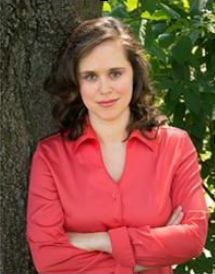|
An Interview with Helene Wecker |
|
A: When I was working on my MFA at Columbia, I started writing a series of short stories that combined tales from my family and from my husband’s family. I’m Jewish and he’s Arab American, and so in that sense we come from two different (and, in many eyes, opposing) cultures. But I’ve always been struck by the similarities between our families, the way that certain themes echo between them. We’re both the children of immigrants, with all that entails. As a result my husband and I both grew up in suburban, picket-fence America—but with the intimate and sometimes uncomfortable burden of another place’s history, and the complications of living as a cultural minority, which affects our relationships with those we love and those we meet. Q: Your male jinni Ahmad arrives in turn of the century NYC’s Little Syria neighborhood (now Lower Manhattan) from inside of an old Syrian copper vase. How is your Jinni different or similar to those of legend? From the Book of One Thousand and One Nights, and the TV show “I Dream of Jeannie,” we have some preconceived ideas about what a jinni is. When you were writing his character, what were you thinking about getting across to the reader? A: I started out on less certain footing with the Jinni than with the Golem, and it took me longer to figure him out. I didn’t realize until I started researching the jinn how much they are an everyday truth for many in the modern Middle East and the Muslim world, and I wanted to be respectful of that. But I also realized that a Western audience would be more familiar with the Thousand and One Nights and pop culture versions. In the end, I kept coming back to the idea of a creature created from fire, and how that might translate to his personality: impulsive, passionate, dazzling, dangerous. It struck me that such a creature would have a very hard time camouflaging himself in New York society. Whether consciously or not, I think I drew from Western fantasy as well, from elves and brownies and so on, which are sort of like the British and European cousins of the jinn: strong-willed, mischevious, and usually hidden. But one thing I was certain of, pretty much from the beginning, was that my jinni wouldn’t be granting any wishes! Q: You decided to give your golem and jinni free will and fairly strong-willed personalities, even though they are both bound to masters. How did you come to this decision, and what are the consequences? A: Funny enough, it was never really a decision. I think their strong personalities came about because they’re both bound and limited, and forced to live in a state that isn’t quite natural to either of them. I knew the interesting stuff would happen when they came up against those limitations. As for the consequences, it meant that they’re constantly arguing! Q: Besides the main characters, who else was the most fun to write? A: It’s hard to choose, but I think Saleh was my favorite supporting character to write. He was a huge surprise to me. I was researching Little Syria, and I found an article in the New-York Daily Tribune written in 1892. One of the illustrations was of a man in a turban, sitting in front of a wooden churn. The caption was “An Ice-Cream Seller.” I thought, who is that guy? And suddenly I knew. I wrote his backstory in one long, frenzied session. It felt like an unlooked-for gift. I grew very attached to Saleh – he’s such a great curmudgeon. Q: In writing and researching this novel, what most surprised you? A: One thing that surprised me quite a bit, and shouldn’t have, was the diversity of Jewish religion and philosophy at the turn of the century. It’s far too easy to think of past peoples as monolithic, and the past as “a simpler time,” when of course it was anything but. I hadn’t realized the extent of the Socialist movement in the Jewish community, or the vehement variety of opinions on the budding Zionist movement. They probably tried to teach me all this at Sunday school, but I was too busy reading Dragonlance novels in the back. Q: What makes your novel relevant today? A: A good question, considering it’s set over a hundred years ago, and has two supernatural creatures for main characters. But over and over, my research told me that the concerns and dilemmas of 1900s-era New Yorkers would be very familiar to the modern reader. They worried about multiculturalism and globalism, the tensions between science and religion, between tradition and assimilation. It became clear to me that we have always been finding and losing our faiths; we have always struggled to defend or flaunt propriety, to follow or ignore the dictates of our hearts. * * * |
|

 In 2013 Helene Wecker sat down with her publisher HarperCollins to talk about the inspiration behind her debut novel,
In 2013 Helene Wecker sat down with her publisher HarperCollins to talk about the inspiration behind her debut novel,